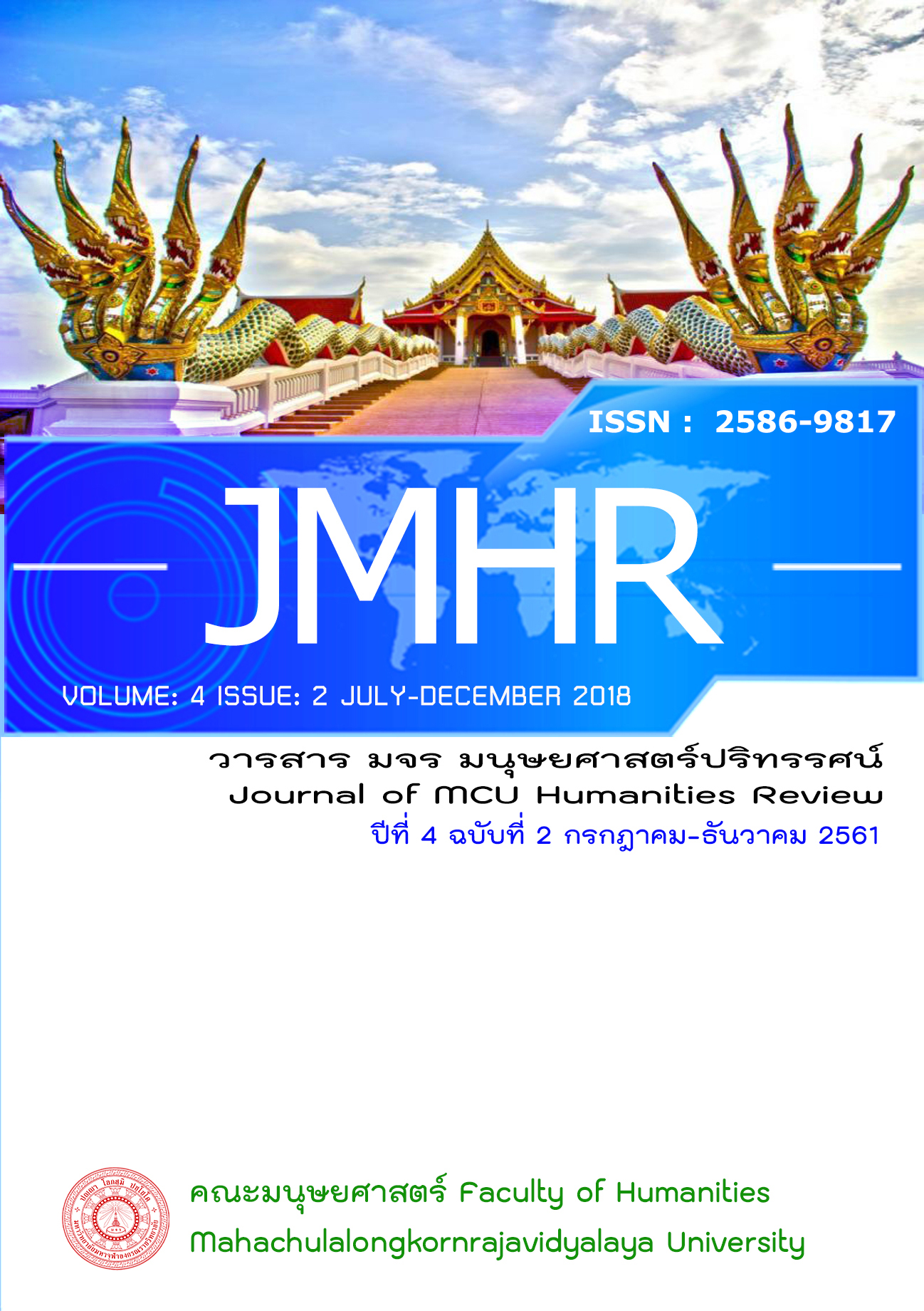การเสริมสร้างความเข้มแข็งพระพุทธศาสนาในสังคมร่วมสมัย
บทคัดย่อ
พระพุทธศาสนาเริ่มประดิษฐานมั่นคงนับแต่ที่พระพุทธเจ้าทรงเผยแผ่ตลอด 45 พรรษา พุทธบริษัทมีการศึกษา ปฏิบัติ เผยแผ่ และปกป้องรักษาพระพุทธศาสนาอย่างเต็มกำลังความสามารถ หลังจากที่พระพุทธเจ้าเสด็จดับขันธปรินิพพาน พระพุทธศาสนาได้เผชิญกับเหตุการณ์ที่มีทั้งเป็นความเสี่ยงต่อความมั่นคงและมีความเจริญรุ่งเรืองโดยกระจายไปสู่ดินแดนอื่นนอกเหนือจากประเทศอินเดียจนกระทั่งถึงพุทธศตวรรษที่ 18 พระพุทธศาสนาเสื่อมสูญไปจากอินเดีย แต่ด้วยวิสัยทัศน์และความศรัทธาที่มีต่อพระพุทธศาสนาอย่างแรงกล้า พระเจ้าอโศกมหาราชจึงได้ส่งสมณทูตไปเผยแผ่พระพุทธศาสนา 9 สายในราวต้นพุทธศตวรรษที่ 3 ในสายที่แปดได้เข้ามาสู่ดินแดนสุวรรณภูมิ พระพุทธศาสนาจึงเจริญรุ่งเรืองอยู่ในดินแดนแถบนี้ตั้งแต่ยุคทราวดีจนมาถึงยุคสมัยสุโขทัย พระพุทธศาสนาแบบเถรวาทตามแนวศรีลังกาได้รับการยอมรับและเผยแผ่จนมาถึงปัจจุบัน อาศัยพุทธบริษัททั้ง 4 ทำงานประสานสัมพันธ์กันโดยมีพระสงฆ์และกษัตริย์เป็นองค์ประกอบสำคัญในการสร้างความมั่นคง
ปัจจัยที่มีอิทธิพลต่อความมั่นคงของพระพุทธศาสนาและสถานการณ์ความมั่นคงของพระพุทธศาสนาในสังคมไทยปัจจุบัน แบ่งออกเป็น 4 ด้านพบว่า ด้านศาสนบุคคลยังขาดกระบวนการพัฒนาและการคัดกรองเข้าสู่สงฆ์และตำแหน่ง ด้านศาสนวัตถุ ตกอยู่ภายใต้อำนาจทุนนิยม บริโภคนิยม และพัฒนาผิดทาง ด้านศาสนพิธี ขาดการนำไปสู่การพัฒนาศรัทธาสู่ปัญญา ด้านศาสนธรรม เกิดความเชื่อต่อผู้สอนมากกว่าหลักธรรมที่แท้จริงตามพระไตรปิฎก เพราะใฝ่เรียนรู้ด้วยตนเองน้อย เกิดการอธิบายหลักธรรมสำคัญแตกต่างกัน ซึ่งเป็นภัยภายใน ที่ชาวพุทธหากร่วมมือกันแก้ไขปัญหาก็จะทำให้พระพุทธศาสนามั่นคงได้ และภัยจากลัทธิและศาสนาอื่นซึ่งเป็นภัยภายนอกที่แทรกซึมเข้ามาอย่างหนักในช่วงสิบกว่าปีที่ผ่านมา รุกเข้ามาทั้งในด้านเศรษฐกิจการเมือง การศึกษา ภัยนี้หากชาวพุทธไม่รู้เท่าทันและไม่ร่วมกันแก้ไขปัญหาไว้แต่เนิ่นๆ ย่อมเสี่ยงต่อการสูญสิ้นพระพุทธศาสนาอย่างฉับพลันเพียงแค่ชั่วอายุคนอย่างเช่นกรณีประเทศอินเดีย อินโดนีเซีย อัฟกานิสถาน ในอดีต
เอกสารอ้างอิง
1.1 ข้อมูลปฐมภูมิ
มหาจุฬาลงกรณราชวิทยาลัย. (2539). พระไตรปิฎกภาษาบาลีฉบับมหาจุฬาลงกรณราชวิทยาลัย.
กรุงเทพฯ: โรงพิมพ์มหาจุฬาลงกรณราชวิทยาลัย.
_________. (2539). พระไตรปิฎกภาษาไทยฉบับมหาจุฬาลงกรณราชวิทยาลัย. กรุงเทพฯ:
โรงพิมพ์มหาจุฬาลงกรณราชวิทยาลัย.
1.2 ข้อมูลทุติยภูมิ
1.2.1 หนังสือ (ภาษาไทย) :
กนก แสนประเสริฐ. (2549). ประมวลพระราชบัญญัติคณะสงฆ์. กรุงเทพฯ: โรงพิมพ์สำนักงาน
พระพุทธศาสนาแห่งชาติ.
กรมการศาสนา. (2525). ประวัติพระพุทธศาสนาแห่งกรุงรัตนโกสินทร์ 200 ปี ภาค 1. กรุงเทพฯ:
โรงพิมพ์กรมการศาสนา.
_________. (2554). ความรู้ศาสนาเบื้องต้น. กรุงเทพฯ: โรงพิมพ์ชุมนุมสหกรณ์การเกษตรแห่ง
ประเทศไทย.
_________. (2540). คู่มือวิทยากรอบรมพระสังฆาธิการระดับเจ้าอาวาส. กรุงเทพฯ: โรงพิมพ์การศาสนา.
กรมการศาสนา กระทรวงวัฒนธรรม. (2556). คู่มือการปฏิบัติศาสนพิธีเบื้องต้น. กรุงเทพฯ:
โรงพิมพ์ชุมนุมสหกรณ์การเกษตรแห่งประเทศไทย.
กรมการศาสนา กระทรวงศึกษาธิการ. (2538). คู่มือการบริหารศึกษาคณะสงฆ์. กรุงเทพฯ:
โรงพิมพ์กรมศาสนา.
_________ . (2540). คู่มือวิทยากรอบรมพระสังฆาธิการระดับเจ้าอาวาส. กรุงเทพฯ:
โรงพิมพ์การศาสนา.
_________. (2521). ประวัติการปกครองคณะสงฆ์ไทย. กรุงเทพฯ:
โรงพิมพ์มหามกุฎราชวิทยาลัยในพระบรมราชูปถัมภ์.
__________. (2542). ความหมายของวัด. กรุงเทพฯ: โรงพิมพ์กรมการศาสนา.
_________. (2542). คู่มือการบริหารจัดการวัดฉบับย่อ. กรุงเทพฯ: โรงพิมพ์การศาสนา.
__________. (2539). หลักการบริหารและการจัดการวัดในยุคโลกาภิวัตน์. กรุงเทพฯ: เอพี
กราฟิคดีไซน์.
_________. (2542). หนังสือคู่มือพระสังฆาธิการว่าด้วยพระราชบัญญัติกฎระเบียบคำสั่งมหาเถร-
สมาคม. กรุงเทพฯ: กรมการศาสนา.
_________. (2534). วิชาการพระพุทธศาสนา. กรุงเทพฯ: โรงพิมพ์กรมการศาสนา.
_________. (2535). วินัยบัญญัตินักธรรมชั้นตรี. กรุงเทพฯ: โรงพิมพ์กรมการศาสนา.
_________. (2527). ประวัติการปกครองคณะสงฆ์ไทย. กรุงเทพฯ: โรงพิมพ์การศาสนา.
กรมพระยาดำรงราชานุภาพ, สมเด็จ. (2514). ประชุมนิพนธ์เกี่ยวกับตำนานทางพระพุทธศาสนา.
กรุงเทพฯ: โรงพิมพ์โสภณพิพรรฒธนากร.
พระธรรมโกศาจารย์ (ประยูร ธมมจิตโต). (2549). พุทธวิธีบริหาร (พิมพ์ครั้งที่ 4). กรุงเทพฯ:
โรงพิมพ์มหาจุฬาลงกรณราชวิทยาลัย.
พระธรรมปิฎก (ป.อ. ปยุตฺโต). (2543). รู้จักพระไตรปิฎกเพื่อเป็นชาวพุทธที่แท้. กรุงเทพฯ:
บริษัท สหธรรมิก จํากัด.
_________. (2540). พระพุทธศาสนาในอาเซีย. กรุงเทพฯ: ธรรมสภา.
_________. (2545). ภัยในพระพุทธศาสนา. กรุงเทพฯ: มูลนิธิพุทธธรรม.
_________. (2540). พระพุทธศาสนาในอาเซีย. กรุงเทพฯ: โรงพิมพ์ธรรมสภา.
_________. (2539). จาริกบุญ-จาริกธรรม. กรุงเทพฯ: สหธรรมมิก.
_________. (2537). ธรรมนูญชีวิต. กรุงเทพฯ: โรงพิมพ์การศาสนา.
_________. (2544). นิติศาสตร์แนวพุทธ (พิมพ์ครั้งที่ 5). กรุงเทพฯ: บริษัทพิมพ์สวย จำกัด.
_________. (2543). พจนานุกรมพุทธศาสตร์ฉบับประมวลศัพท์. กรุงเทพฯ: มหาจุฬาลงกรณราชวิทยาลัย.
พระธรรมวรนายก (โอภาส นิรุตฺติเมธี). (2546). การพัฒนาวัดให้เป็นศูนย์กลางของชุมชนใน
ธรรมปริทัศน์ 46. กรุงเทพฯ: โรงพิมพ์มหาจุฬาลงกรณ์ราชวิทยาลัย.
พระบาทสมเด็จพระมงกุฎเกล้าเจ้าอยู่หัว. (2461). “เครื่องหมายแห่งไตรรงค์”ในหนังสือดุสิตเสมา
ฉบับพิเศษ. (ม.ป.ท.)






